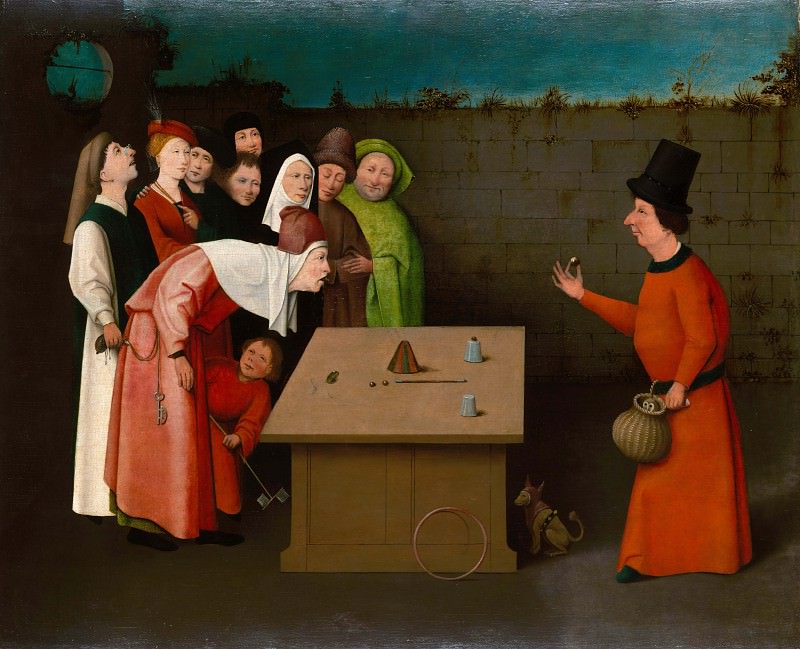The Magician (follower) Hieronymus Bosch (1450-1516)
Hieronymus Bosch – The Magician (follower)
Edit attribution
Download full size: 7184×5827 px (5,7 Mb)
Painter: Hieronymus Bosch
Location: City Museum (Musée municipal), Saint-Germain-en-Laye.
The painting "The Magician" by the Flemish painter Hieronymus Bosch, unfortunately, has not survived. Today we can admire only copies of the work. The most accurate is recognized as a work that is housed in the Saint-Germain-en-Laye Museum. The date of the original is also unknown, only presumably referring to Bosch’s early work. It corresponds to the unsteady figures and the disruption of perspective reduction, corresponding to the immaturity of the master. The painting is an example of the age-old satire that reminds us of how blind faith and stupidity ruin people.
Description of Hieronymus Bosch’s painting The Magician
The painting "The Magician" by the Flemish painter Hieronymus Bosch, unfortunately, has not survived. Today we can admire only copies of the work. The most accurate is recognized as a work that is housed in the Saint-Germain-en-Laye Museum.
The date of the original is also unknown, only presumably referring to Bosch’s early work. It corresponds to the unsteady figures and the disruption of perspective reduction, corresponding to the immaturity of the master.
The painting is an example of the age-old satire that reminds us of how blind faith and stupidity ruin people. The plot of this scene has two interpretations. Some scholars call it a warning against swindlers and a rebuke to those fools who are willing to believe cunning and dexterous peddlers. A magician and curious onlookers are seated near the slick stone wall.
On the table you can see the tools of the charlatan, fooling the gullible public. It is not immediately possible to distinguish a frog at the left edge of the table, over which one of the spectators is leaning in amazement. The magician had just convinced him and the rest of the audience that it had magically jumped right out of the man’s mouth. In this way, having completely captured the crowd’s attention, the charlatan gives another trickster, or perhaps his own partner, the opportunity to empty the pockets of simpletons. The theatrical deception is expressed by the symbols of an owl, a prototype of the devil’s intrigues, and a dog dressed as a jester.
Others trace in the extraction of the frog an appeal to the church rite of exorcism. From this point of view, "The Trickster" is not just a humorous skit, but a mockery of the clergy, like a fake magician fooling the heads of the congregation.
The Trickster is often seen as a satire on tricksters and foolish rascals who are willing to put their faith in any rogue. In the extraction of the frog, art historians suggest a mockery of the church rite of exorcism.
The painting takes on an anti-religious protest and becomes a parody of clergymen who fool naive parishioners. This version is reinforced by the magician’s dress, which resembles a cardinal’s cassock, and the thief’s outfit, that of a Dominican monk.
Кому понравилось
Пожалуйста, подождите
На эту операцию может потребоваться несколько секунд.
Информация появится в новом окне,
если открытие новых окон не запрещено в настройках вашего браузера.
You need to login
Для работы с коллекциями – пожалуйста, войдите в аккаунт (open in new window).




















You cannot comment Why?
A diverse group of onlookers surrounds the performer. Their expressions range from rapt attention to skepticism and amusement. A woman in pink attire leans forward intently, while a young boy clings to her skirt, mirroring her curiosity. Further back, several individuals display more reserved reactions – one man appears almost scornful, another seems bewildered. The varied responses suggest a spectrum of belief and understanding within the community observing this spectacle.
The table itself is covered with an assortment of items that contribute to the enigmatic atmosphere: small cones, bells, a ruler, a hoop, and what looks like a rabbit’s foot. These objects are not readily identifiable as tools for any conventional trade or craft; instead, they evoke a sense of arcane knowledge and potentially deceptive practices. The presence of the crescent moon visible through a window in the wall adds another layer of symbolic complexity, hinting at lunar cycles, hidden truths, and perhaps even witchcraft.
The composition is carefully structured to draw attention to the magician’s performance. He occupies a prominent position on the right side of the canvas, bathed in light that contrasts with the darker background. The walled enclosure creates a sense of containment, isolating this event from the wider world and emphasizing its peculiar nature.
Subtly, the painting seems to explore themes of perception versus reality, faith versus doubt, and the allure of the mysterious. It invites contemplation on the power of illusion and the human desire to be deceived or amazed. The artist’s choice of clothing styles suggests a specific historical context, likely late medieval or early Renaissance Europe, where such traveling performers were often viewed with suspicion and fascination.